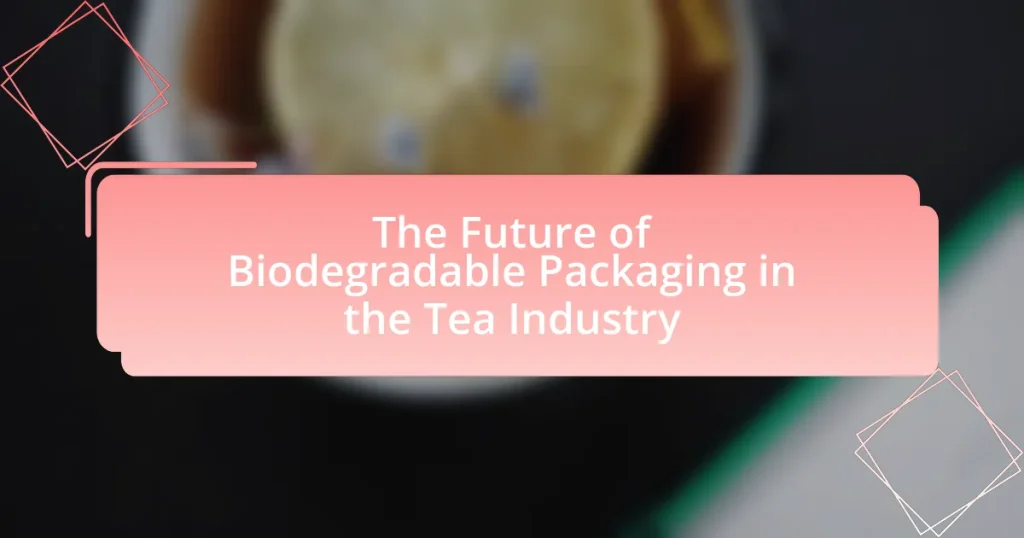The main entity of the article is biodegradable packaging in the tea industry. The article explores the promising future of biodegradable packaging driven by consumer demand for sustainability and regulatory pressures to reduce plastic waste. It discusses the definition of biodegradable packaging, commonly used materials, and the environmental impacts of traditional packaging. Key trends shaping the industry, such as advancements in material technology and shifting consumer preferences, are highlighted, along with the challenges faced by tea producers in adopting these eco-friendly alternatives. The article also examines regulatory considerations and best practices for companies transitioning to biodegradable packaging, emphasizing the importance of sustainability in enhancing brand reputation and market competitiveness.

What is the Future of Biodegradable Packaging in the Tea Industry?
The future of biodegradable packaging in the tea industry is promising, driven by increasing consumer demand for sustainable practices and regulatory pressures to reduce plastic waste. As of 2023, the global biodegradable packaging market is projected to grow significantly, with a compound annual growth rate (CAGR) of around 14% from 2021 to 2028, indicating a strong shift towards eco-friendly materials. Companies in the tea sector are increasingly adopting materials like plant-based bioplastics and compostable paper, which not only meet environmental standards but also appeal to eco-conscious consumers. This trend is supported by research from the European Bioplastics Association, which highlights that biodegradable options can effectively reduce the carbon footprint associated with traditional packaging.
How is biodegradable packaging defined in the context of the tea industry?
Biodegradable packaging in the context of the tea industry is defined as packaging materials that can decompose naturally through the action of microorganisms, thereby reducing environmental impact. This type of packaging is increasingly utilized by tea producers to align with sustainability goals and consumer demand for eco-friendly products. For instance, materials such as plant-based bioplastics and compostable paper are commonly used, as they break down within a specific timeframe, unlike traditional plastics which can persist in the environment for hundreds of years. The adoption of biodegradable packaging in the tea industry not only helps in minimizing waste but also enhances the brand image by appealing to environmentally conscious consumers.
What materials are commonly used in biodegradable packaging for tea?
Common materials used in biodegradable packaging for tea include plant-based plastics, paper, and compostable films. Plant-based plastics, such as polylactic acid (PLA), are derived from renewable resources like corn starch and are designed to break down in industrial composting facilities. Paper packaging, often made from recycled materials, is biodegradable and can decompose naturally. Compostable films, made from materials like cellulose, provide a barrier to moisture and oxygen while being environmentally friendly. These materials are increasingly favored in the tea industry due to their reduced environmental impact compared to traditional plastics.
How does biodegradable packaging differ from traditional packaging?
Biodegradable packaging differs from traditional packaging primarily in its ability to decompose naturally and return to the environment without leaving harmful residues. Traditional packaging, often made from plastics, can take hundreds of years to break down and contributes significantly to environmental pollution. In contrast, biodegradable packaging is typically made from materials such as plant-based substances, which can break down within months under the right conditions, as evidenced by studies showing that certain biodegradable materials can decompose in composting environments within 90 to 180 days. This fundamental difference highlights the environmental benefits of biodegradable options, particularly in industries like tea, where sustainable practices are increasingly prioritized.
Why is biodegradable packaging important for the tea industry?
Biodegradable packaging is important for the tea industry because it reduces environmental impact and aligns with consumer demand for sustainable practices. The tea industry generates significant waste through traditional packaging, which often contributes to pollution and landfill overflow. According to a study by the World Economic Forum, packaging waste accounts for approximately 30% of global waste, highlighting the need for alternatives. Biodegradable packaging, made from materials that decompose naturally, helps mitigate this issue by minimizing plastic pollution and promoting a circular economy. Additionally, as consumers increasingly prefer eco-friendly products, adopting biodegradable packaging can enhance brand reputation and market competitiveness within the tea sector.
What environmental impacts does traditional tea packaging have?
Traditional tea packaging has significant environmental impacts primarily due to its reliance on non-biodegradable materials such as plastic and aluminum. These materials contribute to pollution and landfill waste, as they can take hundreds of years to decompose. For instance, a study by the World Economic Forum indicates that approximately 8 million tons of plastic enter the oceans annually, much of which comes from packaging waste. Additionally, traditional packaging often involves energy-intensive production processes that emit greenhouse gases, further exacerbating climate change. The use of chemical dyes and coatings in packaging can also lead to soil and water contamination, affecting ecosystems and human health.
How can biodegradable packaging reduce waste in the tea industry?
Biodegradable packaging can significantly reduce waste in the tea industry by breaking down naturally and minimizing landfill contributions. Traditional plastic packaging often persists in the environment for hundreds of years, whereas biodegradable materials, such as plant-based plastics or compostable films, decompose within months under the right conditions. This transition can lead to a reduction in plastic pollution, as evidenced by a study from the University of Cambridge, which found that biodegradable alternatives can reduce overall waste by up to 30% in specific applications. By adopting biodegradable packaging, tea producers can align with sustainability goals, enhance their brand image, and contribute to a circular economy, ultimately leading to less environmental impact.
What trends are shaping the future of biodegradable packaging in the tea industry?
The future of biodegradable packaging in the tea industry is being shaped by several key trends, including increased consumer demand for sustainable products, advancements in material technology, and regulatory pressures for eco-friendly packaging solutions. Consumer preferences are shifting towards environmentally responsible options, with a 2021 survey indicating that 72% of consumers are willing to pay more for sustainable packaging. Innovations in materials, such as plant-based bioplastics and compostable films, are enhancing the functionality and appeal of biodegradable packaging. Additionally, governments worldwide are implementing stricter regulations on single-use plastics, prompting tea companies to adopt biodegradable alternatives to comply with these laws and meet consumer expectations.
How are consumer preferences influencing biodegradable packaging choices?
Consumer preferences are significantly influencing biodegradable packaging choices by driving demand for sustainable materials that align with environmental values. As consumers increasingly prioritize eco-friendliness, brands in the tea industry are responding by adopting biodegradable packaging solutions to meet these expectations. A survey conducted by Nielsen in 2019 revealed that 73% of global consumers are willing to change their consumption habits to reduce environmental impact, highlighting the importance of sustainability in purchasing decisions. Consequently, tea companies are investing in biodegradable options, such as plant-based plastics and compostable materials, to attract environmentally conscious consumers and enhance brand loyalty.
What innovations are emerging in biodegradable packaging technologies?
Innovations in biodegradable packaging technologies include the development of plant-based materials, such as polylactic acid (PLA) and polyhydroxyalkanoates (PHA), which are derived from renewable resources. These materials are designed to decompose more quickly than traditional plastics, reducing environmental impact. Recent advancements also involve the incorporation of natural additives, like starch and cellulose, to enhance the biodegradability and mechanical properties of packaging. For instance, a study published in the journal “Biomacromolecules” highlights that PLA blends with natural fibers can improve strength while maintaining biodegradability. Additionally, companies are exploring the use of mycelium, the root structure of fungi, as a sustainable packaging alternative that can break down in composting environments. These innovations are crucial for the tea industry, where sustainable packaging solutions can align with consumer preferences for eco-friendly products.
How does the tea industry currently implement biodegradable packaging?
The tea industry currently implements biodegradable packaging by utilizing materials such as plant-based bioplastics, compostable paper, and natural fibers. Companies like Tetley and Unilever have adopted these materials to replace traditional plastic packaging, aiming to reduce environmental impact. For instance, Tetley has introduced tea bags made from biodegradable materials that decompose within a few months, demonstrating a commitment to sustainability. This shift is supported by consumer demand for eco-friendly products, with a report from Grand View Research indicating that the global biodegradable packaging market is expected to reach $500 billion by 2027, highlighting the industry’s trend towards sustainable practices.
What are the challenges faced by tea producers in adopting biodegradable packaging?
Tea producers face several challenges in adopting biodegradable packaging, primarily related to cost, performance, and consumer acceptance. The production costs of biodegradable materials are often higher than traditional plastics, which can strain the budgets of tea producers, especially smaller ones. Additionally, biodegradable packaging may not always provide the same level of protection and shelf life as conventional packaging, leading to concerns about product quality and waste. Furthermore, consumer awareness and acceptance of biodegradable options can vary, impacting market demand. According to a study by the European Commission, only 30% of consumers are aware of biodegradable packaging, indicating a need for education and marketing efforts to promote these sustainable alternatives.
How are companies successfully integrating biodegradable packaging into their supply chains?
Companies are successfully integrating biodegradable packaging into their supply chains by adopting innovative materials and collaborating with suppliers to ensure sustainability. For instance, tea companies are increasingly using plant-based materials, such as cornstarch and sugarcane, which decompose naturally and reduce environmental impact. A notable example is the partnership between Unilever and various packaging firms to develop compostable tea bags, which has led to a significant reduction in plastic waste. Additionally, companies are implementing lifecycle assessments to evaluate the environmental benefits of biodegradable options, ensuring that their supply chains align with sustainability goals. This strategic approach not only enhances brand reputation but also meets consumer demand for eco-friendly products.
What are the regulatory considerations for biodegradable packaging in the tea industry?
Regulatory considerations for biodegradable packaging in the tea industry include compliance with national and international standards for biodegradability, safety assessments, and labeling requirements. In many jurisdictions, biodegradable packaging must meet specific criteria set by organizations such as ASTM International or the European Bioplastics Association, which define the conditions under which materials can be classified as biodegradable. Additionally, manufacturers must ensure that their packaging does not contain harmful substances that could leach into the tea, adhering to food safety regulations established by agencies like the FDA in the United States or EFSA in Europe. These regulations are crucial for maintaining consumer safety and environmental integrity, as they help ensure that biodegradable materials break down effectively without leaving harmful residues.
What standards must biodegradable packaging meet to be considered compliant?
Biodegradable packaging must meet specific standards such as ASTM D6400 or EN 13432 to be considered compliant. These standards define the criteria for biodegradability, compostability, and the environmental impact of the materials used. For instance, ASTM D6400 requires that the packaging breaks down into carbon dioxide, water, and biomass within a specified time frame in a composting environment, while EN 13432 mandates that the material must disintegrate and not leave harmful residues. Compliance with these standards ensures that biodegradable packaging effectively contributes to waste reduction and environmental sustainability.
How do regulations vary across different regions for biodegradable packaging?
Regulations for biodegradable packaging vary significantly across different regions, reflecting local environmental policies and consumer preferences. In the European Union, stringent regulations mandate that biodegradable materials meet specific standards, such as EN 13432, which requires products to decompose within 12 weeks in industrial composting facilities. In contrast, the United States has a more fragmented regulatory landscape, with some states like California implementing strict composting laws, while others lack comprehensive regulations. Additionally, countries like Japan promote biodegradable packaging through incentives but do not enforce strict compliance measures. These regional differences highlight the need for businesses in the tea industry to navigate varying legal frameworks to ensure compliance and sustainability in their packaging choices.
What are the future prospects for biodegradable packaging in the tea industry?
The future prospects for biodegradable packaging in the tea industry are promising, driven by increasing consumer demand for sustainable products and regulatory pressures to reduce plastic waste. The global biodegradable packaging market is projected to grow significantly, with a compound annual growth rate (CAGR) of over 14% from 2021 to 2028, indicating a strong shift towards eco-friendly alternatives. Companies in the tea sector are increasingly adopting materials such as plant-based bioplastics and compostable films, which align with sustainability goals and consumer preferences. This trend is supported by research from the European Bioplastics Association, which highlights that biodegradable packaging can effectively reduce environmental impact while maintaining product integrity.
How might consumer demand evolve regarding sustainable packaging in tea?
Consumer demand for sustainable packaging in tea is likely to increase significantly as environmental awareness grows. Research indicates that 66% of global consumers are willing to pay more for sustainable brands, reflecting a shift towards eco-friendly practices. This trend is driven by heightened concerns over plastic pollution and climate change, prompting tea companies to adopt biodegradable and recyclable packaging solutions. As a result, brands that prioritize sustainability in their packaging are expected to gain a competitive advantage, aligning with consumer preferences for environmentally responsible products.
What role will technology play in the advancement of biodegradable packaging solutions?
Technology will play a crucial role in advancing biodegradable packaging solutions by enabling the development of innovative materials and processes that enhance biodegradability and functionality. For instance, advancements in biopolymer research have led to the creation of materials derived from renewable resources, such as cornstarch and cellulose, which decompose more efficiently than traditional plastics. Additionally, technologies like 3D printing and nanotechnology are being utilized to create packaging that is not only biodegradable but also offers improved barrier properties, extending shelf life and maintaining product quality. Research indicates that the global biodegradable plastics market is expected to reach $6.9 billion by 2025, driven by technological innovations that meet consumer demand for sustainable packaging options.
What best practices should tea companies follow when transitioning to biodegradable packaging?
Tea companies should prioritize sourcing materials that are certified biodegradable and compostable when transitioning to biodegradable packaging. This ensures that the packaging will break down effectively in natural environments, reducing environmental impact. Additionally, companies should conduct thorough testing of the packaging to confirm its performance in preserving tea quality and freshness, as studies indicate that inadequate packaging can lead to product spoilage. Furthermore, educating consumers about the benefits and proper disposal methods of biodegradable packaging can enhance customer engagement and promote sustainable practices. Implementing these best practices aligns with industry trends towards sustainability and can improve brand reputation among environmentally conscious consumers.


